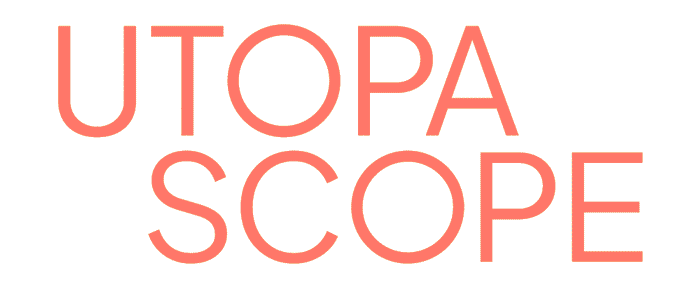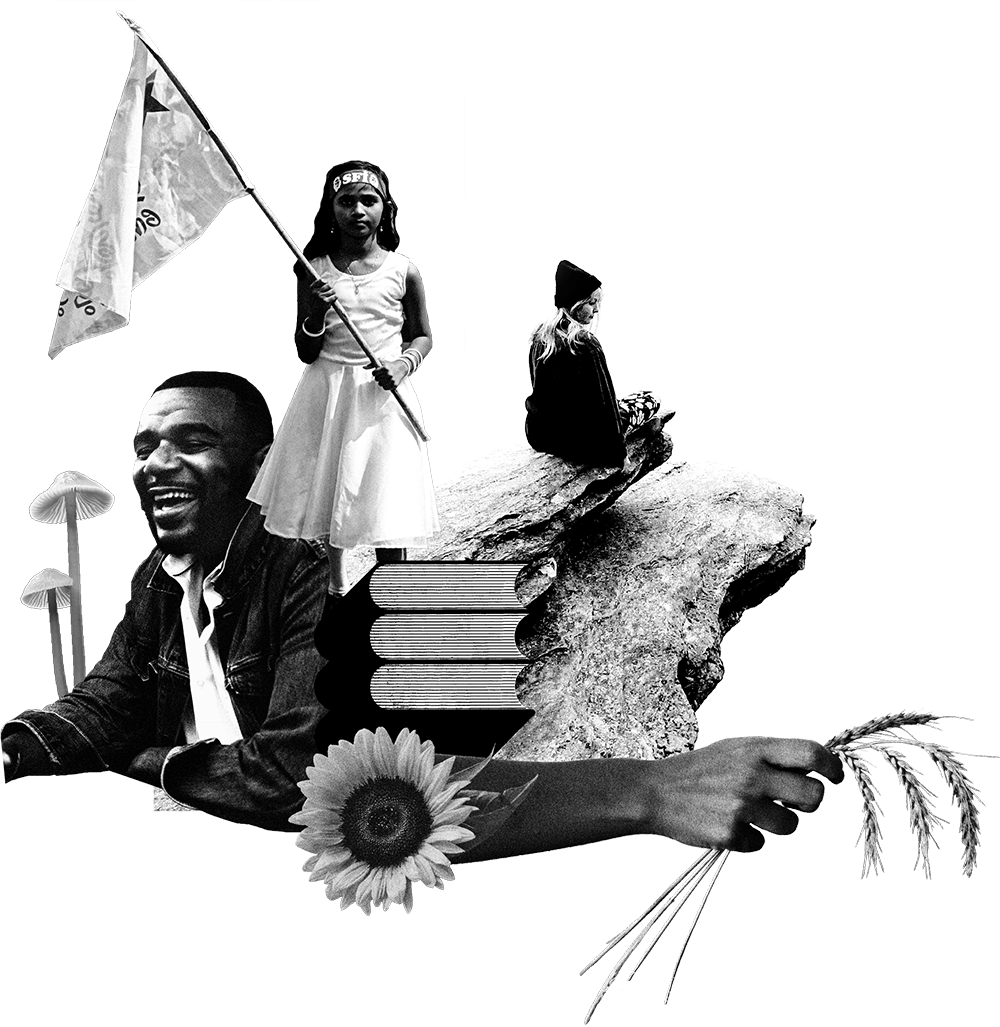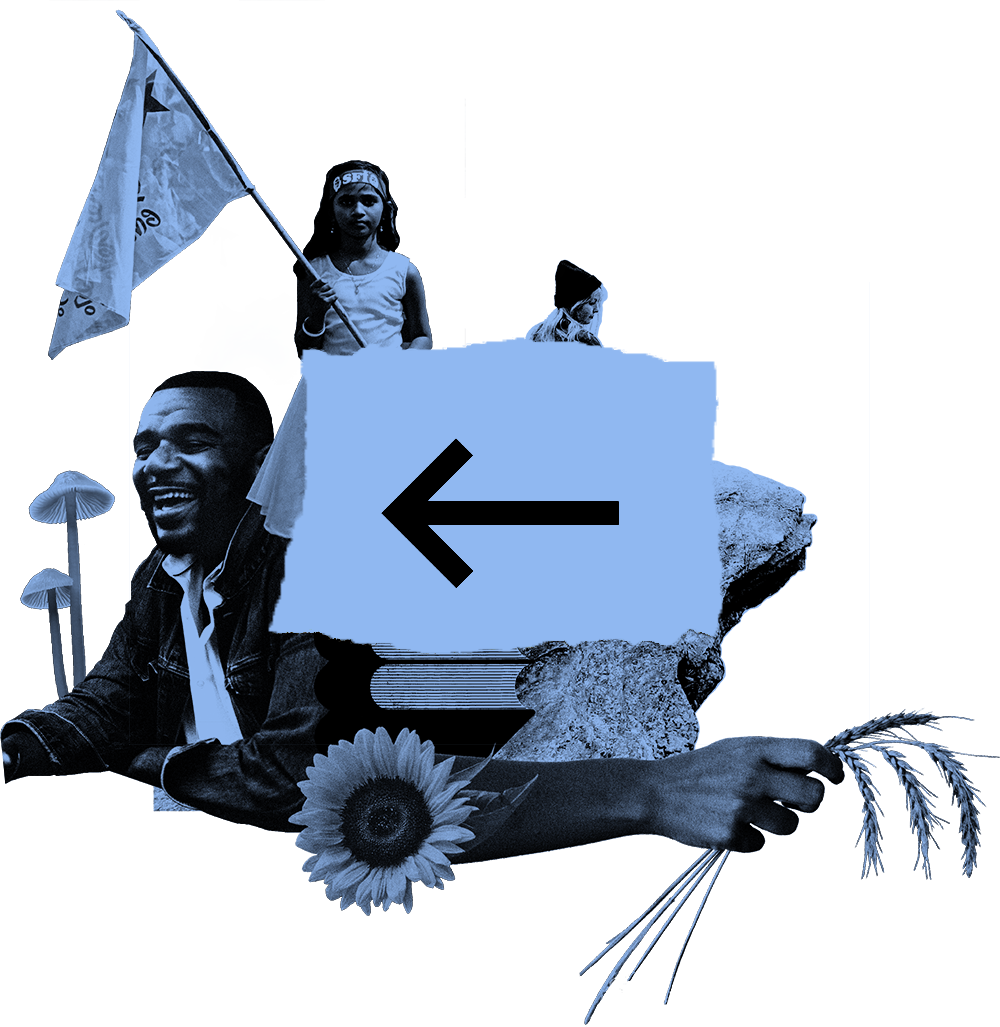Reduce stress
vote to organize!
Imagine a city with a massive coalition of everyday people who one day decide to take radical action to address the stress and anxiety of modern life. While some segments strike at the root cause of societal pressures that commonly lead to stress—money, inequality, oppression—others want to do something about lifting one another up in the more immediate term. Would they create a city-wide network of volunteer-run counseling centers? Might they organize their own block-level social services to get the most vulnerable in touch with the help they need, both grassroots and institutional? Could they band together to take excursions out into nature? Might they teach free, accessible classes in public spaces about radical self-care, centering solidarity and intersectionality? Could they make creative spaces for low-stakes, easy, and free recreation, taking inspiration from Iceland, where natural hot springs are the primary social gathering spaces in the community?
As an activist and community organizer, it’s important to recognize the signs of fatigue, burnout, and stress so you can address them and reduce their impact before they overwhelm you. There are many techniques that organizations can use for reducing stress and promoting wellness among their members and communities. These range from mindfulness and meditation, to therapy or behavioral changes, to spending time together or facilitating connection with friends and family members. Everyone’s stressors and reactions to stress are different; your organization should find ways to help each person identify their own stressors and how to combat them so that they can benefit the entirety of the group and community as one big collective, as well as the individuals.
Organizations can serve many different roles and functions in the community, and it’s the people of the community who should democratically determine what their needs are. Most groups tend to prioritize more urgent, tangible needs above stress reduction. That doesn’t mean that people can’t organize structures and programs within their organizations to emphasize radical community care alongside their initiatives to engage in mutual aid and social justice, in order to both protect the mental health of the people in the community and to strengthen their projects and actions.
The rematriation and reparations practice explores some ideas about how social services and institutions have failed a lot of people, and that a community organization that wants to engage in this type of work might want to consider creating a people-powered community center to circumvent those old broken systems. A committee in a community organization might borrow some of those ideas to help all people reduce their stress using some tried and true methods.
Community
In times of stress, turn to your community for support. Spending time with friends and chosen family who care about your well-being can give you a respite from mental stressors. Talk to them about what you’re feeling or just spend time together doing activities you enjoy.
Your organization can encourage this on an individual level, but might also create structures and space for casual support and communal, free, relaxing, recreational spaces for groups of friends to gather and relax with one another. So few opportunities exist to enjoy free “third places” (that are not home or work) that it may fall to the people to reinvent their own.
Therapy
Some people find it beneficial to talk to someone who is objective and outside of their network of friends and family. Therapists can help you identify your personal stressors and suggest techniques for combating them. There are many types of therapy, and while not all of them are affordable you can find free or low-cost resources in most communities, or your community can create your own if none exist or if those that do are inadequate.
If you have health insurance, start by searching for local therapists that accept your particular coverage. Check with your provider to see how much your copay costs — it may be more affordable than you think. You may also be able to access care from out of network therapists by paying out of pocket up front and then submitting a request for reimbursement to your provider. Don’t be afraid to ask therapists if they offer a reduced rate or sliding scale based on your income level. Some therapists may offer free or reduced-rate services to a small number of patients as a benefit to the community or be able to recommend other affordable options in your area. Your organization may create support systems to help people in the community navigate the difficult maze that is insurance and networks of care providers.
Schools and universities can also be a resource for free or low-cost therapy services. Student organizers in your community may be able to help facilitate connections between the educational institution and the neighbors, and can enjoy those services themselves. Graduate student training programs train students to become professional therapists, and are often accessible to the general public. Although you and your neighbors may be working with inexperienced practitioners, they can still provide you with a high level of care. An organized coalition could create their own systems to surface these free services to the broader community.
Community and religious organizations may also offer free or affordable services, and can be an especially good resource for connecting with a peer support group if you’re not committed to one-on-one counseling. Look for a group that matches your specific needs and help connect your neighbors to it. Alternatively, your organization could set up your own peer support groups, block by block.
If you can’t access in-person services, you still have a number of other options. Consider using an online service or accessing a hotline. Hotlines can be especially helpful if you or a loved one is experiencing a crisis and need to speak with someone immediately.
Also, you could potentially partner with fellow community organizers who are trained therapists, counselors, and social workers in order to create your own free volunteer co-operative needs-based clinic if none exist in the community.
If you need more information about what services are available in your area, try calling 211 or visiting 211.org.
Self-care
If you and your neighbors don’t feel you have the time, money, or desire to participate in therapy or group support, you can still make positive changes to your behavior on your own that will reduce your stress levels and your organization can help facilitate radical self-care. While you can’t control everything that your life and activism work throws at you, you can work on identifying the things that are within your control and focus on making positive changes to those aspects of your life. You may need to try out different self-care techniques to see what works for you.
Take stock of all the organizations and causes you are currently doing work with and what tasks you’ve taken on for each one. Be honest with yourself about whether or not you’ve overcommitted yourself. If so, assess what tasks you can continue to commit to and then ask to hand off the remaining tasks to other organizers.
Rather than waiting until you’re overcommitted, learn to say “no” to taking on new tasks when your plate is full. Saying yes to everything to the point of being overwhelmed will not serve you or your work well. Be selective about what you say yes to so that you can do your best work. In the end, this practice will help everyone.
If the work itself has become draining or unfulfilling, ask yourself what type of work would be a better fit for you and then see if you can switch to a different role within the organization that better aligns with your needs. This will allow you to stay committed to a cause you care about without compromising your mental health.
Sometimes, reducing your workload or switching gears may not be enough. You may need to completely step away from a movement or organization for a certain period of time to focus on other aspects of your life. It’s okay to do this. Taking the time you need for yourself will ensure that you’re healthier and more effective if you choose to return to the cause later on.
Identify and put an end to negative self-talk. You may feel guilty about saying no or pausing to take a break. Activists often feel like they are not doing enough if they take time to rest and re-energize, but this pattern of thought is self-defeating and will only compound feelings of stress. Remember that you are one person and that activism and organizing are collective activities. While your contribution is important, you cannot and do not need to do everything, all the time.
Tune into yourself physically and mentally. Pay attention to how your mind and body respond in stressful situations. Allow yourself to feel whatever emotions and physical sensations you’re feeling without judging yourself. Acknowledge the thoughts you’re having and then give yourself permission to let them pass. Don’t ignore the physical feelings of stress in your body. Instead take time out to stretch, do breathing exercises, go for a walk, journal, or simply sit and relax.
Finally, be sure to regularly take time to step back and consider your work. Think about everything you and your organization has done over the past 3 months, 6 months, a year. Doing this will help you maintain perspective on your accomplishments, which will in turn help you feel motivated to continue pushing forward toward the goals you hope to accomplish in the future. Your organization itself should also reference organizing goal-setting methods, which defines ways to set achievable goals that only reference the best results, and discontinues those that don’t perform. It’s important for organizers to see some small incremental accomplishments over time or else the organizers will start to experience burnout on a mass level.
Mindfulness and meditation
Mindfulness refers to the idea of being present in the moment and attuned to what is going on inside and around us, and meditation is a practice that can help you lead a mindful life. Activists may find that practicing these techniques rooted in Buddhist traditions dating as far back as the third century BCE can help them lower their stress reaction, accept setbacks in their life and work, and maintain perspective and focus. Discovery of a path towards liberation was and is one of the Buddhist purposes of meditation, of special note for those who wish to build a better world. There are many online resources for getting started with mindfulness and meditation practices and there may even be community groups in your area that offer in-person meetups or other free-to-the-public resources. If not, your organization could start up your own meditation and mindfulness programs for free for the community. Be mindful, though, of cultural appropriation and determine when and if it is correct for your organization to do so.
Deep breathing
In addition to mindfulness and meditation, deep breathing exercises can help with the physical manifestations of stress and return you to a more peaceful state. Stress triggers the sympathetic nervous system, which leads the body into “fight-or-flight” response. In this state, your heart beats faster, your breathing quickens, and your blood vessels constrict. Deep breathing exercises can combat these changes in your body by helping to activate your parasympathetic nervous system. When you practice deep breathing, you focus on deepening and slowing down your breathing, which in turn helps slow your racing heart.
There are many deep breathing methods you can try, including belly breathing, alternate nostril breathing, equal breathing, paced breathing, and more. Test out a few exercises and see what works best for you. These practices could be incorporated into any group therapy or meditation courses.
Acupuncture and acupressure
Acupuncture and acupressure are forms of traditional Chinese medicine that can help relieve stress, ease chronic pain, and treat other ailments. As with counseling services, you can find practices that operate on a sliding-scale payment model in many communities. There’s also always the possibility that acupuncturists and acupressurists may want to organize with you in order to lend their knowledge to the movement.
Sleep, exercise, and spend time outdoors
Lastly, make sure you’re getting adequate sleep, making time for exercise or some type of physical activity, and getting outside in nature. Don’t sign up to run a marathon if you don’t naturally gravitate toward running—the pressure of a new and challenging goal will only add stress—but do find something that works well for you. That could be a low intensity activity like yoga or tai chi, a restorative walk or hike in the woods or a park near you, or something fun that takes you out of your comfort zone like roller skating or a dance class. Anything that gives your brain and body time to rest and rebuild is beneficial. Most of all, create systems within the organization to encourage and help your members engage in healthy physical activity. Organize giant social justice-themed scavenger hunts and games around the community, find active ways to engage in environmental justice by going on seedbombing excursions, host protest music dance parties spinning Wilson Pickett, Steel Pulse, and Public Enemy, explore a place you believe no one has ever been, or invent an entirely new cooperative community sport of your own.




